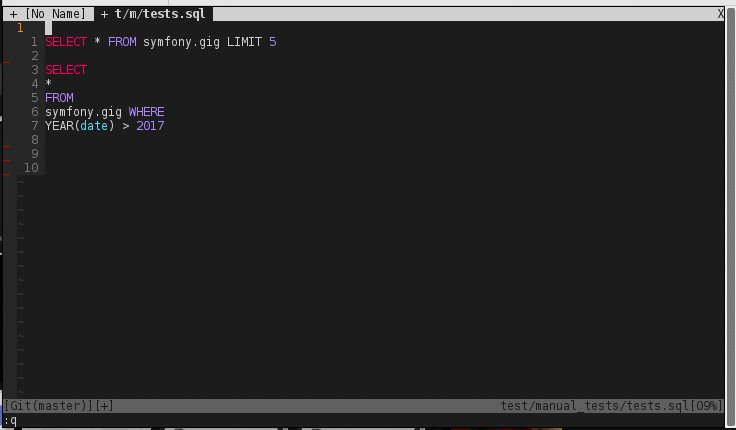SQHell.vim
 SQHell.vim copied to clipboard
SQHell.vim copied to clipboard
An SQL wrapper for vim
SQHell.vim
An SQL wrapper for Vim. Execute commands, sort results, navigate tables and databases and so much more!
The supported providers at the moment are
- MySQL
- Postgres
- Sqlite
It started off simply enough:
nnoremap <leader>xc :r !mysql -uroot -psomepass -h somehost.com <<< `cat %` \| column -t<cr>
It grew from there...
Examples
(Gifs are using the data from my band bogans)
Execute a command using SQHExecute!
Execute a line with SQHExecute.
Execute a visual block with SQHExecute over a visual selection.
Execute an arbitrary command with SQHExecute!.

Execute a file using SQHExecuteFile
SQHExecuteFile will work on the current buffer if no file is supplied

Explore the database with buffer aware mappings

Installation
Vim Plug
Plug 'joereynolds/SQHell.vim'
Configuration
Connection details will need to be supplied in order for SQHell.vim to connect to your DBMS of choice. The connections are in a dictionary to let you manage multiple hosts. By default SQHell uses the 'default' key details (no surprise there)
Example:
let g:sqh_provider = 'psql'
let g:sqh_connections = {
\ 'default': {
\ 'user': 'root',
\ 'password': 'testing345',
\ 'host': 'localhost'
\},
\ 'live': {
\ 'user': 'root',
\ 'password': 'jerw5Y^$Hdfj',
\ 'host': '46.121.44.392'
\}
\}
You can use the SQHSwitchConnection function to change hosts.
i.e. SQHSwitchConnection live
SQHell currently supports 3 providers and fallsback to MySQL if none specificed.
The 3 providers are:
-
mysql- A connection to a MySQL DB. Specify it withlet g:sqh_provider = 'mysql' -
psql- A connection to a Postgres DB. Specify it withlet g:sqh_provider = 'psql' -
sqlite- A connection to a Sqlite DB. Specify it withlet g:sqh_provider = 'sqlite'
I strongly suggest that the above configuration details are kept outside of version control and gitignored in your global gitignore.
Default Keybindings
SQHell creates 3 filetypes to make navigation a nicer experience. These are SQHDatabase, SQHTable, and SQHResult
SQHDatabase
Inside an SQHDatabase you can press the following
dd - Drop the database (don't worry there's a prompt).
e - To see all the tables in that database. This will open an SQHTable buffer.
SQHTable
Inside an SQHDatabase you can press the following
dd - Drop the table (don't worry there's a prompt).
e - To see all the results for that table with a limit of g:sqh_results_limit.
This will open an SQHResult buffer
SQHResult
Inside an SQHResult you can press the following
s to sort results by the column the cursor is on.
S to sort results by the column the cursor is on (in reverse).
dd to delete the row WHERE the column is the value under the cursor (don't worry... there's a prompt).
e to edit the current row. This will open an SQHInsert buffer
For more sorting options, you can use :SQHSortResults with extra arguments for the unix sort command, a la :SQHSortResults -rn. It will always sort by the column the cursor is located on.
SQHInsert
Inside an SQHInsert you can press the following
ZZ to close and save the edited row. This will reopen the previous SQHResult buffer
Contributing
Please see the Contributing guidelines if you would like to make SQHell even better!
Tests
Tests use vader.
Tests are housed in the test directory and can be ran by
viming into the test file and running :Vader.
What about dbext, vim-sql-workbench and others?
DBExt is very featureful (and very good) but comes in at a whopping 12000 lines of code. By contrast SQHell.vim is a mere ~200 lines
The setup and installation process for vim-sql-workbench is something that I aim to avoid with SQHell.vim, ideally a 'set and forget' plugin.
There are no clever inferences inside SQHell.vim.